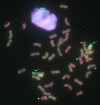Molecular Cytogenetic Identification of a New Wheat-Rye 6R Chromosome Disomic Addition Line with Powdery Mildew Resistance
- PMID: 26237413
- PMCID: PMC4523181
- DOI: 10.1371/journal.pone.0134534
Molecular Cytogenetic Identification of a New Wheat-Rye 6R Chromosome Disomic Addition Line with Powdery Mildew Resistance
Abstract
Rye (Secale cereale L.) possesses many valuable genes that can be used for improving disease resistance, yield and environment adaptation of wheat (Triticum aestivum L.). However, the documented resistance stocks derived from rye is faced severe challenge due to the variation of virulent isolates in the pathogen populations. Therefore, it is necessary to develop desirable germplasm and search for novel resistance gene sources against constantly accumulated variation of the virulent isolates. In the present study, a new wheat-rye line designated as WR49-1 was produced through distant hybridization and chromosome engineering protocols between common wheat cultivar Xiaoyan 6 and rye cultivar German White. Using sequential GISH (genomic in situ hybridization), mc-FISH (multicolor fluorescence in situ hybridization), mc-GISH (multicolor GISH) and EST (expressed sequence tag)-based marker analysis, WR49-1 was proved to be a new wheat-rye 6R disomic addition line. As expected, WR49-1 showed high levels of resistance to wheat powdery mildew (Blumeria graminis f. sp. tritici, Bgt) pathogens prevalent in China at the adult growth stage and 19 of 23 Bgt isolates tested at the seedling stage. According to its reaction pattern to different Bgt isolates, WR49-1 may possess new resistance gene(s) for powdery mildew, which differed from the documented powdery mildew gene, including Pm20 on chromosome arm 6RL of rye. Additionally, WR49-1 was cytologically stable, had improved agronomic characteristics and therefore could serve as an important bridge for wheat breeding and chromosome engineering.
Conflict of interest statement
Figures






References
-
- McDonald BA, Linde C (2002) The population genetics of plant pathogens and breeding strategies for durable resistance. Euphytica 124: 163–180.
-
- He ZH, Lan CX, Chen XM, Zou YC, Zhuang QS, et al. (2011) Progress and perspective in research of adult-plant resistance to stripe rust and powdery mildew in wheat. Scientia Agricultura Sinica 44: 2193–2215.
-
- Friebe B, Jiang J, Raupp W, McIntosh R, Gill B (1996) Characterization of wheat-alien translocations conferring resistance to diseases and pests: current status. Euphytica 91: 59–87.
-
- Rabinovich SV (1998) Importance of wheat-rye translocations for breeding modern cultivars of Triticum aestivum L. Euphytica 100: 323–340.
-
- Zhuang Q (2003) Chinese wheat improvement and pedigree analysis. Chinese Agriculture Press, Beijing, China.
Publication types
MeSH terms
LinkOut - more resources
Full Text Sources
Other Literature Sources
Medical
Research Materials

